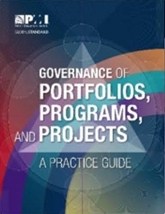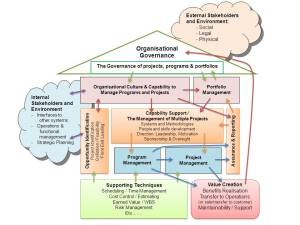 PMI’s newly released Practice Guide for the Governance of Portfolios, Programs, and Projects, provides some useful guidance to organisations and practitioners on the implementation of the management of portfolios, programs, and projects, but very little on the governance of this important aspect of most organisations.
PMI’s newly released Practice Guide for the Governance of Portfolios, Programs, and Projects, provides some useful guidance to organisations and practitioners on the implementation of the management of portfolios, programs, and projects, but very little on the governance of this important aspect of most organisations.
The understanding of project management, program management and portfolio management is well developed and easily accessible to all organisations, many of which have well developed capabilities in these areas, but most still see their projects and programs fail on a regular basis. Our 2012 post Project or Management Failures? highlighted the issues.
The source of many of these failures lies in the organisation’s ability to manage the overall function of ‘doing projects’ – defined by Professor Peter Morris as ‘the management of projects’ to differentiate this area of middle and executive management from traditional ‘project and program management’. The overall domain covered by the ‘the management of projects’ concept is outlined in our White Paper WP1079 The Strategic Management of Projects.
Despite confusing the governance function and the management function, this PMI Practice Guide is a valuable contribution to this area of management and to a lesser extent the governance of projects, programs and portfolios. As previously mentioned, the major weakness in the PMI Practice Guide is its failure to differentiate and understand the different functions of governance and management. Whilst this confusion is common in documents prepared by practitioners and academics focused on IT management and project management, it is rarely seen in any other area of management.
Governance is the exclusive responsibility of an organisation’s governing body; in corporations this is the ‘board of directors’, in other types of organisation, their equivalent. The governing body is responsible for setting the objectives, culture, and ethical framework for the organisation, employing the organisation’s senior management, oversighting the organisation’s management functions and providing assurance to external stakeholders the organisation is operating effectively and conforming to its obligations (for more on this see: WP 1096 The Functions of Governance). Elements of some of these functions can be delegated to management, particularly in the areas of surveillance and assurance, but accountability remains with the governing body. Importantly in a well governed organisation, the governing body does not interfere in or directly undertake the management of the organisation – it is impossible to govern your own work!
The functions of management were defined 100 years ago by Henri Fayol in his book Administration Industrielle et Generale. Management involves planning, forecasting, employing other managers and workers, and organising as in creating the organisation; then coordinating, controlling and directing the work of suppliers and subordinates to achieve the organisation’s objectives; whilst working within the ethical and cultural framework set by the governing body (for more on this see: WP 1094 The Functions of Management). A key function of every management role is ensuring subordinates and suppliers conform to the ‘rules’ set by the governing body.
In short, the role of governance is to set the objectives and rules; the role of management is to manage the resources of the organisation to achieve its objectives, working within the ‘rules’. This approach to governance is clearly defined in ISO 38500 the international standard for the corporate governance of information technology, and ISO 21505 the draft international standard for the governance of projects, programs and portfolios. PMI has completely failed to understand this distinction and as a consequence invented a range of meaningless definitions in the Practice Guide along with a framework that defines basic management functions such as providing resources to undertake work as ‘governance’.
The simple fact of life is the governing body employs managers to undertake management functions and this involves allocating resources, deciding on priorities and making decisions within the strategic framework approved by the governing body. The basic functions of management were clearly defined by Henri Fayol in 1916 had have stood the test of time and the rigours of academic scrutiny.
The tragedy of the decision by PMI to ignore legislation, international standards and a range of governance authorities ranging from the OECD to Cadbury and try to invent its own definition of governance, is that in the PMI model, virtually every management role above that of the project manager is turned into a ‘governance role’.
The proposition made by PMI that every manager responsible for organising and coordinating the work of subordinate managers is engaged in governance is simply untenable – good effective prudent management is simply good effective prudent management!
The role of governance is to create the environment that allows good effective prudent management to occur; ensure the organisation employs people capable of implementing good effective prudent management and to oversee the working of management so the governors can provide assurance to the organisation’s stakeholders that their management team is in fact providing good effective prudent management. The actual work of providing good effective prudent management to achieve the objectives of the organisation is the role, responsibility and duty of managers
Strangely enough most people in real governance positions know what governance is and know what management is. Alienating this group is a real pity because once you get past the problem of describing almost every management role as a ‘governance role’ the Guide contains a lot of very useful information focused on improving the abysmal performance of many organisations in the complex area of the ‘management of projects’.
- Section 2 describes organisational project management and the tailoring management practices to meet organisational needs; the essential relationships and considerations; roles and responsibilities; and domains, functions, and processes. It describes how ‘the management of projects’ can be implemented as a program or project for integrated portfolio, program, and project management.
- Section 3 describes portfolio management, its links to governance and its central role in the ‘management of projects’.
- Section 4 describes program management and Section 5: management at the Project Level.
In summary PMI’s Practice Guide for the Governance of Portfolios, Programs, and Projects is a good attempt to focus attention on the vital executive and middle management roles that routinely fail to properly support the delivery of projects and programs; the Practice Guide is spoiled by the delusion that middle level managers and executives undertaking their normal management responsibilities are somehow ‘governing’ the organisation. As a consequence, the governing bodies of organisations and corporations will tend to dismiss the Practice Guide as an irrelevance.
The key element missed by PMI is the understanding that good management practice is an outcome of good governance, and bad management practice is a symptom of governance failure. The role of governance is to ensure its organisation’s management structures and systems are ‘good’. The fact PMI have completely missed this important distinction in their Practice Guide and as a consequence significantly reduced its value to organisations is an opportunity lost! In most organisations both the governance of projects programs and portfolios needs improving and the overall management of projects programs and portfolios needs improving – these are both important, but require very different improvement processes!


